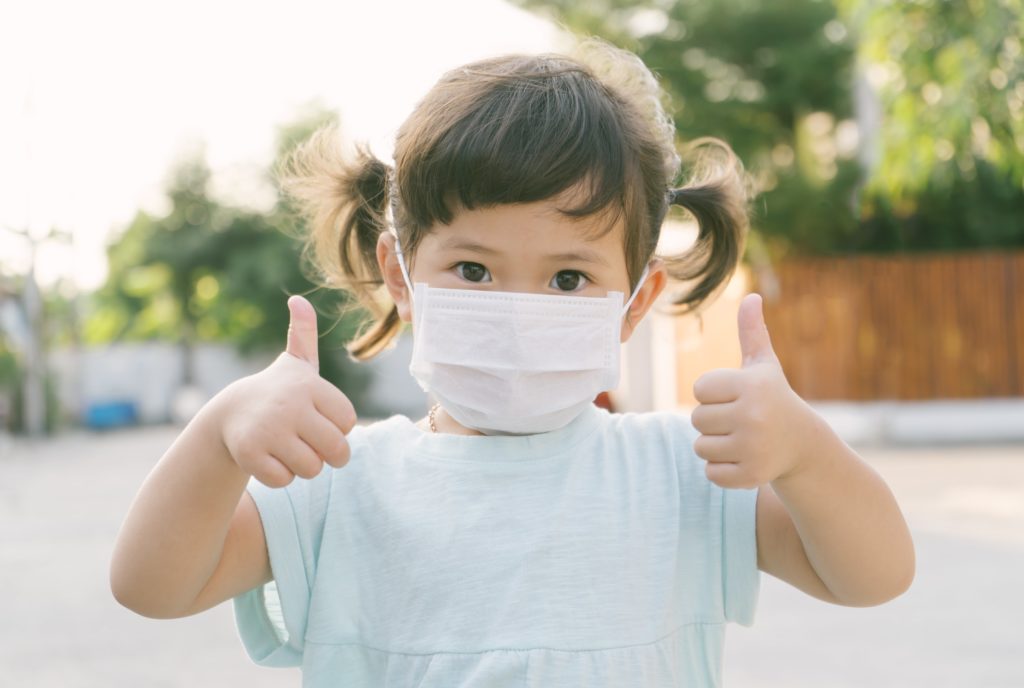Wearing a Mask Can Impact Speech & Hearing
Wearing a mask has become part of our daily life and that continues throughout the current pandemic. We wear masks to stop the spread of COVID-19, to protect ourselves and the people around us. As we log more and more time in masks, many want to understand how wearing a mask can impact speech and hearing. In addition, there are some strategies we can use to ensure that our children are communicating effectively and understand those around them.
Let’s review some important information about masks and communication:
- Wearing a mask removes many visual cues that we get from the speaker.
- Masks attenuate sound by three to twelve decibels and also result in low-pass filtering of high-frequency sounds. This can make it more difficult to understand speech and some higher-pitched voices (Goldin et al., 2020).
- Masks hide many non-verbal cues, such as smiling.
Since masks are necessary, and often required, we can work to ensure that children do not lose skills that may be impacted by wearing a mask.
Here are some ways we can improve communication during this pandemic:
Tips for Improving Communication While Wearing a Mask
- Wear a clear mask. Let’s start with visual cues. Visual cues, such aspointing to your lips to remind the child to close his/her lips when producing /b/ and /p/, are instantly removed when wearing a mask.If you are worried about the loss of these visual cues in speech therapy, teletherapy is a fantastic option! There is no need to wear a mask. If speech therapy must be done in-person, there are now a variety of masks that have a clear section for the mouth so that children (and adults) can see the speaker’s mouth. A quick online search will reveal a number of masks for speech therapists designed to improve service delivery while staying safe. These masks have provided us with one way to offer effective speech therapy while wearing a mask. We can also use videos to show visual cues that have been removed as a result of a mask. In the classroom setting, providing the necessary visual cues may not be possible. In these cases, we turn to the parents for help. If you see your child struggling with a speech sound, try to encourage him/her to watch your mouth at home. If he/she continues to struggle with speech sound production, that’s when you may want to contact a speech therapist.
- Use images and gestures to support understanding and/or rephrase and speak more slowly when wearing a mask. If you or your child is struggling to hear the speaker’s message, the speaker can use visuals (such as pictures) or gestures to support the listener’s understanding. You can find images easily on a phone, tablet, or computer. The speaker can also show what it is that he/she is talking about through pointing or perhaps even acting it out! In addition, the speaker may be able to re-phrase what was said. The use of context can be really helpful in these situations. Last but not least, try to slow down. Decreasing your rate of speech can significantly help with intelligibility.
- Engage with eye contact, use hand gestures, and maintain positive body language when wearing a mask. We need to be a bit more creative when it comes to the loss of non-verbal cues. We also must increase awareness as it’s easy to forget just how much we communicate non-verbally. A thumbs up is an easy gesture that can be used when a smile can’t be seen. Maintaining eye contact and the use of other hand gestures can be helpful as well. A person can also convey emotions and feelings through body posture.
If you have concerns about your child’s development, please don’t hesitate to reach out! TherapyWorks team of pediatric therapists are happy to consult with you and make recommendations. Schedule a free phone consultant or click the button below to answer a few questions about your child. A TherapyWorks team member will follow up with you right away.








